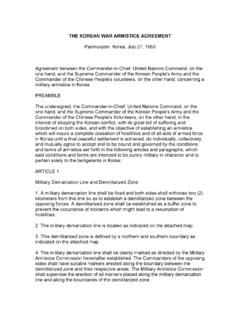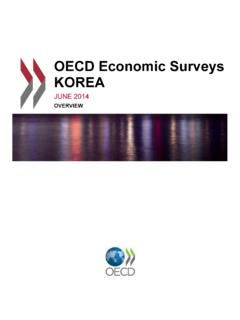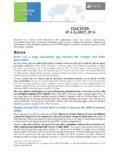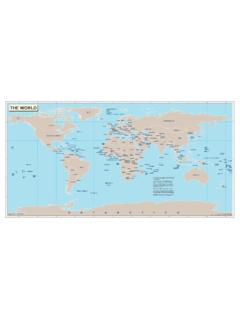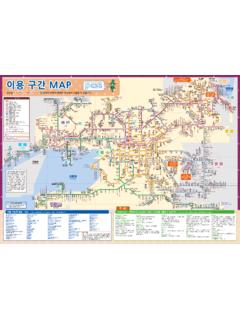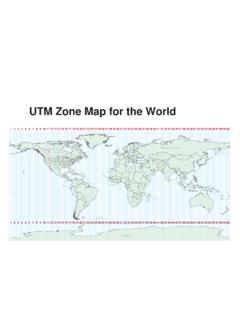Transcription of Current status of Seismic Hazard Map in Korea - J …
1 The 1st Annual Meeting of the Strategic Chinese-Korean-Japanese Cooperative Program : Seismic Hazard Assessment for the Next Generation Map, Harbin, China Current status of Seismic Hazard Map in Korea 2011. 11. 25. Jeong Soo JEON. Earthquake Research Center Korea Institute of Geoscience and Mineral Resources (KIGAM). Background of Korean PSHM. 1995. 1. 17. Hyogo EQ. (M ). 1995. 12. 6. Countermeasure Act for Natural Disaster 1997. 12. 1st PSHM made by Ministry of Construction and Transportation (Supported by Earthquake Engineering Society of Korea ). 2004 Sumatra EQ. (M ), 2005 Pakistan EQ.(M ). 2008. 3. 28. Countermeasure Act for Earthquake Disaster - Recommendation for renewal of PSHM every 5 years - Recommendation for supplying an Active fault map 2009. 3. 1. ~ 2012. 8. 31. Project Title : Making an Active fault map and Seismic Hazard map.
2 - Principal Institute : KIGAM. - Agency : National Emergency Management Agency (NEMA). 97 PSHM. Seismic Source Only using Historical & Instrumental Earthquake Catalog Without considering the geological &. geodetical data Without considering the incompleteness of historical earthquake catalog Path Because of no adequate Seismic attenuation formula for Korean peninsula, Using the attenuation formula of US Eastern region Without considering the frequency dependency PGA(%g) with 10% Site effect probability of exceedence Without considering the site effect in 50 years Annual objects & contents of PSHM Project 1st Year (2009) 2nd Year (2010) 3rd Year(2011). Collect whole available Seismic data and Historical Earthquake Catalog Annual information Collect and sensitivity Revision of PSHM.
3 Objects Analysis of the previous analysis of input parameters research results Analysis the present Operation of specialist PSHM Preparing the Logic tree &. committee & holding the input parameter public hearing to make an Comparison with the unified historical earthquake various procedures Operation of specialist catalog including foreign committee & holding the Contents countries method to public hearing to make an Sensitivity analysis of the make Korean PSHM PSHM. input parameters for PSHM. Operation of specialist Collect & Analysis of the Collect & Analysis of the data committee to develop data related to the site related to the site future research direction amplification amplification and contents National PSHM. Historical & Instrumental Product Site amplification map for Earthquake Catalog 5 metropolitan cities Procedure for PSHM.
4 1. PSHM Methodology Comparison with various PSHM Methodology 2. Sensitivity Analysis of Input Parameters Historical & Instrumental EQ Catalog Attenuation Formula Intensity-Magnitude Conversion Formula Depth, etc 3. Calculation of PSHM. Applying Logic Tree method & Preparing the basic input data/parameter Open consensus-building process ; Operation of specialists committee including the variety major ; Holing the public hearing 1. PSHM Methodology Evaluation of the Spatially Smoothed Method Criteria for Seismic design(II), Ministration of Construction & Transportation, Earthquake Engineering Society of Korea , 1997. Peterson, , and others, 2008, United States National Seismic Hazard Maps Frankel, A. and others, Documentation for the 2002 Update of the National Seismic Hazard Maps Frankel, A.
5 And others, 1996, National Seismic Hazard Maps Evaluation of the Seismic Zoninig Method Cornell, , 1968, Engineering Seismic risk analysis SSHAC, 1997, Recommendations for PSHM, US Nuclear Regulatory Commission report Klugel, 2009, Probabilistic Seismic Hazard analysis for nuclear power plants KOPEC, 2003, Probabilistic Seismic Hazard analysis for SHINWOLSONG 1&2 nuclear power plant site. 1. PSHM Methodology USGS PSHA Method Fault Source Point Source Fault Information Earthquake Catalogue - Lat-Lon, Strike, Dip, Depth - Regional b-value - Slip rate - Maginitude-complteteness times - Maximum Capable EQ Magnitude hazFX hazgridX. Hazard Curves on a grid of lat-lon Hazard Curves on a grid of lat-lon hazallX. Ground Motion with specified annual frequency of excedence 1. PSHM Methodology Active Faults D/B.
6 Contents : Name, Location, Fault type, Strike/Dip, Length, Displacement, Age dating, Lithology, etc 1. PSHM Methodology Sensitivity Analysis of PSHM using by USGS Method - Slip Rate : mm/year [Length: 10km, Mmax : ] [Length: 20km, Mmax : ] [Length: 50km, Mmax : ]. *PGA[%g] for 50years 1. PSHM Methodology Sensitivity Analysis of PSHM using by USGS Method - Slip Rate : mm/year [Length: 10km, Mmax : ] [Length: 20km, Mmax : ] [Length: 50km, Mmax : ]. *PGA[%g] for 50years 2. Input Data/Parameters USGS(2008). ; combine earthquakes from several (reformatted). source catalogs, choose one preferred record for each event that is listed more than once, and decluster to remove aftershocks and foreshocks - Western North America(WNA) Catalog - Central & Eastern North America(CENA) Catalog Japan NIED(2009).
7 ; Chronological Scientific Tables( ). - ~1884 : Tatsuo Usami Catalog( ). - 1885~1925 : Tokuji Utsu( ). - 1926~ : JMA. 2. Input Data/Parameters Collection & Analysis of available earthquake list and research results - (1978), (1978). - (1981). - (1983). - (1984, 1987). - (1985, 1998, 2003, 2005, 2006). : 2,186 historical earthquake list - (1989, 2009). : 2,113 historicla EQ. List - (1997). - (1999). - (2000). (1987) (2006). 2. Input Data/Parameters Historical EQ D/B Construction - Collect all available lists & Publications - Collect EQ information from National & University D/B related to historical record - Adjacent countries D/B and List 2. Input Data/Parameters Setup specific criteria for - Unified Event List - Epicenter determination - Intensity determination ; Felt-area Intensity relationship ; according to the description for Human & Animal Building (castle, fortress, house, wall, etc).
8 Natural phenomenon (surface rupture, shaking, liquefaction, etc). Operation of specialist committee - Confirmation above criterion - Review the final historical EQ catalog - Revaluation for the 64 big historical EQ. Holding the public hearing to make an unified(acceptable?) historical earthquake catalog 2. Input Data/Parameters 1800 1810 1820 1830 1840 1850 1860 1870 1880 1890 1900 1910 1920 1930 1940 1950 1960 1970 1980 1990 2000 2010 . KIGAM 857. KMA 918. LEE&YANG 66. NK 766. NORTH Korea 445. 1. KYUNG 1. EARLY 91. NEIC 207. ISC 849. Organization Duration No. of Events KIGAM 02-08 ~ 2010-11-28 2437. KMA 1978-08-30 ~ 2010-12-20 918. LEE&YANG 02-08 ~ 1904-03-23 1928. NK 27-10 ~ 1985-12-23 1057. NORTH Korea 1905-08-25 ~ 1996-11-17 445. Ministry of Construction 27-00 ~ 1810-01-20 389.
9 KYUNG 27-00 ~ 1810-02-19 449. EARLY 1913-05-12 ~ 1941-12-15 91. NEIC 1973-09-10 ~ 2009-08-10 207. ISC 1905-08-25 ~ 2009-05-01 849. 3. PSHM Calculation USGS(2009). - Construction of specialist committee to conduct the logic tree evaluation, consisted of various major field - Now, finalizing the logic tree & preparing input data and parameters 4. Site Amplification Seismic zonations in an urban area E rthquake Ground Motion Minor hazards Site effects in an urban area Wave Propagation Serious hazards Dynamic Rupture (Path effects). (Source effects). Earthquake By Fault Movement 4. Site Amplification Current Site Classification Scheme in Most Codes Western Region of US. Average Soil Prop Short-Period Mid-Period Soil Profile Type Generic Description Z = Z = Z = Z = (Vs30) (m/s) C. Vs a Fa Ca Fa Cv Fv Cv Fv SA (Site Class A) Hard Rock > 1,500 SB (Site Class B) Rock 760 - 1,500 Very Dense and SC (Site Class C) 360 - 760 Soft Rock SD (Site Class D) Stiff Soil 180 - 360 SE (Site Class E) Soft Soil < 180 SF (Site Class F) Soil Requiring Site-specific Evaluation C : Seismic Coefficient F : Site Amplification Factor Z : Seismic Zone Factor Short Period : ~ sec, Mid-Period : ~ sec 4.
10 Site Amplification Modification of Site Classification Criteria Site Coefficients Generic Description Site Class VS30 (m/s) TG (s) Fa Fv Rock B > 760 < C1 > 620 < Weathered Rock and Very Stiff Soil C2 > 520 < C. C3 > 440 < Intermediate Stiff Soil C4 > 360 < D1 > 320 < D2 > 280 < Deep Stiff Soil D. D3 > 240 < D4 > 180 < Deep Soft Soil E 180 4. Site Amplification For five metropolitan cities, Seoul, Daejeon, Gwangju, Daegu, Busan 125 N 126 N 127 N 128 N 129 N. 39 N 39 N Building the geotechnical DB. composed of the existing borehole drilling data and surface geo- 38 N 38 N knowledge data Seoul Implementing the GIS-based 37 N 37 N. geotechnical information system for spatial geotechnical (geo-) layers Daegu using the geotechnical DB. Daejeon 36 N 36 N Creating a variety of spatial zoning maps for quantifying the site effects in terms of the site period within GIS- 35 N Gwangju based tools 35 N.
